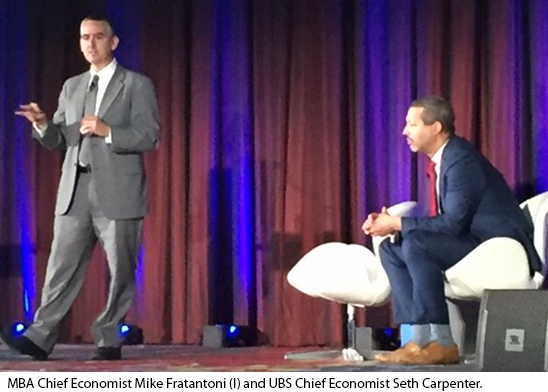
For Lenders, Caution Amid Strong Economic Forecast
NEW YORK–A year after predicting robust economic growth at the previous Mortgage Bankers Association National Secondary Market Conference & Expo, MBA Chief Economist Mike Fratantoni and other economists aren’t ready to change the script.
“We see a generally positive economic outlook,” said Seth B. Carpenter, U.S. Chief Economist with UBS, New York. “The U.S. economy pushed higher at the end of 2017; and the fiscal policy [tax cut] provided a further boost. Despite a first quarter slowdown, consumption spending remains healthy and should accelerate in line with the faster pace of disposable income growth.”
 However, MBA Chief Economist Mike Fratantoni sounded a cautionary note, warning that lenders face an increasingly competitive environment that will likely squeeze profits–and even profitability.
However, MBA Chief Economist Mike Fratantoni sounded a cautionary note, warning that lenders face an increasingly competitive environment that will likely squeeze profits–and even profitability.
“For lenders, margins continue to be tight,” Fratantoni said, noting the latest MBA Mortgage Performance Report showed continued regulations, additional fixed costs, intense competition and the shift from refi to purchase continued to eat away at mortgage profits. “The trend is negative for originations,” he said. “And we’re also seeing a lot of independent mortgage banks more willing to give up servicing.”
Fratantoni said “quite favorable demographics” support household formation. “We’ve got six or seven years of extraordinarily strong housing demand ahead of us as more and more Millennials hit the prime home-buying age,” he said.
But refinance volume, Fratantoni noted, “has probably hit a floor,” particularly as 30-year fixed mortgage rates continue to rates. “Lenders who are well-positioned for growth in the purchase mortgage market will have the advantage,” he said.
Purchase application volume is running 5 percent ahead of a year ago, Fratantoni said. In 2016, purchase/refi volume was roughly 50-50; for 2018, MBA says mortgage origination volume is expected to drop to $1.6 trillion, with three-fourths of that volume purchase originations. “The refi volume that takes place tends to be cash-out at this point,” he said. “Once you have no more incentive from rates for a refi, then cashing out equity is the more likely path.”
But Fratantoni noted there is still a sense of holding back in the market–“and the reason is inventory,” he said. “You would think there would be a lot of home building going on, given the extraordinary demand, but the shortages are happening everywhere. And it’s going to be a continuing challenge going forward.”
The economic downturn hit construction really hard, Fratantoni noted, taking away a lot of workers in single-family construction who have not returned, despite improving economic conditions. “Builders have a record number of job openings, and they can’t fill those positions,” he said. “The labor constraint will solve itself, but it takes time.”
Land availability is also low, Fratantoni noted, “and that is a process that moves slowly.” He also cited lumber shortages and tariffs. “We expect 1.5 million new households every year; we’re only producing 1.3 million units,” he said. “We’re digging a hole that we can’t get out of right now.”
Carpenter said core Consumer Price Index inflation is forecast to hit 2.4 percent by end of 2018 and core PCE inflation set to reach 2.1 percent. “That is a rise from idiosyncratically low inflation from previous years,” he said. “Core goods inflation is likely to stay soft as retail pressures persist; tighter labor markets support the upward trend.”
Carpenter said the labor market is approaching full employment; nonetheless, “we expect the current conditions to pull even more people into the labor force in the short term,” he said.
UBS predicts three more Federal Open Market Committee rate hikes this year and three more in 2019; MBA sees the same.
Carpenter sees few risks down the line; however, he did warn that growth could accelerate too quickly. And looking further ahead, “In 2019, all bets are off,” he said.
